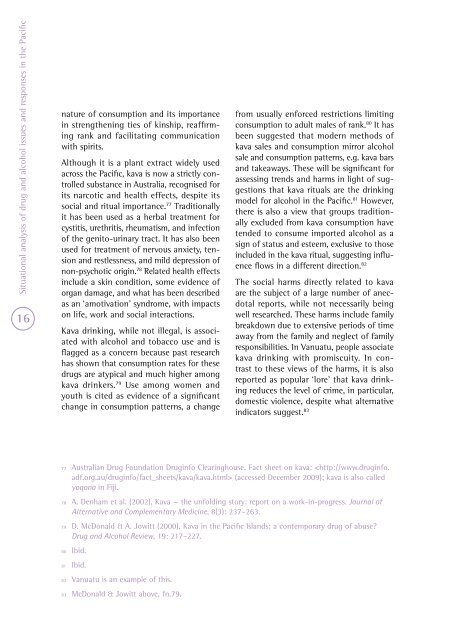rp21 situational analysis - Pacific Health Voices
rp21 situational analysis - Pacific Health Voices
rp21 situational analysis - Pacific Health Voices
Create successful ePaper yourself
Turn your PDF publications into a flip-book with our unique Google optimized e-Paper software.
Situational <strong>analysis</strong> of drug and alcohol issues and responses in the <strong>Pacific</strong><br />
16<br />
nature of consumption and its importance<br />
in strengthening ties of kinship, reaffirming<br />
rank and facilitating communication<br />
with spirits.<br />
Although it is a plant extract widely used<br />
across the <strong>Pacific</strong>, kava is now a strictly controlled<br />
substance in Australia, recognised for<br />
its narcotic and health effects, despite its<br />
social and ritual importance. 77 Traditionally<br />
it has been used as a herbal treatment for<br />
cystitis, urethritis, rheumatism, and infection<br />
of the genito-urinary tract. It has also been<br />
used for treatment of nervous anxiety, tension<br />
and restlessness, and mild depression of<br />
non-psychotic origin. 78 Related health effects<br />
include a skin condition, some evidence of<br />
organ damage, and what has been described<br />
as an ‘amotivation’ syndrome, with impacts<br />
on life, work and social interactions.<br />
Kava drinking, while not illegal, is associated<br />
with alcohol and tobacco use and is<br />
flagged as a concern because past research<br />
has shown that consumption rates for these<br />
drugs are atypical and much higher among<br />
kava drinkers. 79 Use among women and<br />
youth is cited as evidence of a significant<br />
change in consumption patterns, a change<br />
from usually enforced restrictions limiting<br />
consumption to adult males of rank. 80 It has<br />
been suggested that modern methods of<br />
kava sales and consumption mirror alcohol<br />
sale and consumption patterns, e.g. kava bars<br />
and takeaways. These will be significant for<br />
assessing trends and harms in light of suggestions<br />
that kava rituals are the drinking<br />
model for alcohol in the <strong>Pacific</strong>. 81 However,<br />
there is also a view that groups traditionally<br />
excluded from kava consumption have<br />
tended to consume imported alcohol as a<br />
sign of status and esteem, exclusive to those<br />
included in the kava ritual, suggesting influence<br />
flows in a different direction. 82<br />
The social harms directly related to kava<br />
are the subject of a large number of anecdotal<br />
reports, while not necessarily being<br />
well researched. These harms include family<br />
breakdown due to extensive periods of time<br />
away from the family and neglect of family<br />
responsibilities. In Vanuatu, people associate<br />
kava drinking with promiscuity. In contrast<br />
to these views of the harms, it is also<br />
reported as popular ‘lore’ that kava drinking<br />
reduces the level of crime, in particular,<br />
domestic violence, despite what alternative<br />
indicators suggest. 83<br />
77 Australian Drug Foundation Druginfo Clearinghouse, Fact sheet on kava: (accessed December 2009); kava is also called<br />
yoqona in Fiji.<br />
78 A. Denham et al. (2002), Kava — the unfolding story: report on a work-in-progress. Journal of<br />
Alternative and Complementary Medicine, 8(3): 237–263.<br />
79 D. McDonald & A. Jowitt (2000), Kava in the <strong>Pacific</strong> Islands: a contemporary drug of abuse?<br />
Drug and Alcohol Review, 19: 217–227.<br />
80 Ibid.<br />
81 Ibid.<br />
82 Vanuatu is an example of this.<br />
83 McDonald & Jowitt above, fn.79.
















